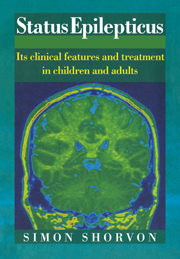Book contents
- Frontmatter
- Contents
- Preface
- 1 The concept of status epilepticus and its history
- 2 Definition, classification and frequency of status epilepticus
- 3 Clinical forms of status epilepticus
- 4 Neurophysiology, neuropathology and neurochemistry of status epilepticus
- 5 Emergency treatment of status epilepticus
- 6 Prognosis and outcome of status epilepticus
- References
- Index
2 - Definition, classification and frequency of status epilepticus
Published online by Cambridge University Press: 15 September 2009
- Frontmatter
- Contents
- Preface
- 1 The concept of status epilepticus and its history
- 2 Definition, classification and frequency of status epilepticus
- 3 Clinical forms of status epilepticus
- 4 Neurophysiology, neuropathology and neurochemistry of status epilepticus
- 5 Emergency treatment of status epilepticus
- 6 Prognosis and outcome of status epilepticus
- References
- Index
Summary
If the clinician, as observer, wishes to see things as they really are, he must make a tabula rasa of his mind, and proceed without any preconceived notions whatsoever.
(Charcot 1889)Definition of status epilepticus
With Charcot's wise counsel, let us start with definitions. We have seen, in chapter 1, how theoretical constructs of status evolved, and how the subject was last seriously considered at the Marseilles Colloquium in 1962. The exegesis of status arrived at is one which has been widely adopted. It is the basis of the WHO dictionary definition of status as ‘a condition characterised by epileptic seizures that are sufficiently prolonged or repeated at sufficiently brief intervals so as to produce an unvarying and enduring epileptic condition’ (Gastaut 1973; an ‘etymological’ definition, which was an extension of the ‘historical’ definition confined to grand mal status). It has been carefully worded in order to incorporate what was seen at Marseilles as the increasing proliferation of ‘enduring epileptic conditions’, all with a compelling claim to be included in the family of status. When Bourneville recognised the special nature of prolonged seizures, his concern was only tonic—clonic convulsions (état de grand mal), and definition was relatively simple. With the subsequent identification of nonconvulsive status, epilepsia partialis continua, neonatal status, absence status, myoclonic status, and childhood status syndromes, the definition had to be widened.
- Type
- Chapter
- Information
- Status EpilepticusIts Clinical Features and Treatment in Children and Adults, pp. 21 - 33Publisher: Cambridge University PressPrint publication year: 1994
- 12
- Cited by



